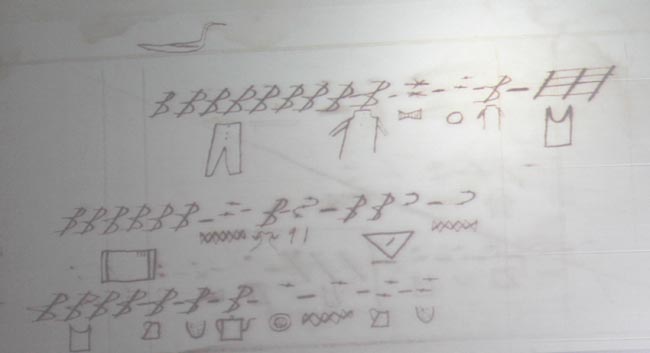Chief’s trading ledger tells a Dokis story

By Marci Becking
DOKIS FIRST NATION – Norm Dokis Jr. says that stories connect people, places and names of the landscape.
“I remember a story someone tells me because of the passion in how it’s told,” says Norm at a June 17 storytelling workshop in Dokis. “We need to hear the stories of our dodems. No one admits to being Sucker Clan – who wants to be a bottom feeder? Bottom feeders have a purpose. All Giigoon is good. We didn’t put one fish on a pedestal more than another. Clans were celebrated.”
The storytelling workshop is part of a larger water project spearheaded by Carly Dokis, assistant professor of anthropology at Nipissing University.
“We’ve spent the last two years building a relationship with Dokis First Nation,” says Carly. “As a research team, we want to fully represent knowledge and experience. This is a community-based project where people share their stories. Water is life, and people and places are connected to that through story.”
The Near North Media Lab has also teamed up with the project, building capacity with the community with video equipment so that they can make and edit their own digital stories.
“The stories will be uploaded to a digital map and will be connected to the places. The community will have access to stories that will commemorate its history,” says Carly. “Our hope is to create an inquisitive research culture in a community with their own equipment.”
Carly explains that some stories capture history of the Dokis culture, child-rearing, living on the water and land use.
Norm, whose job with the Ministry of Natural Resources office in North Bay involves serving as liaison for First Nations in the area, says that this project is a great way to connect western knowledge with traditional knowledge.
“Change is a burden and a blessing,” says Norm. “Change with water is real – there is a science behind the traditional knowledge.”
Norm’s presentation of Chief Michael Eagle Dokis’ trading ledger from 1845-1880 fascinated the group with drawings of people the Chief encountered in trading.
A dodem or a drawing of the person was done on the top left corner of the ledger. In one drawing, Chief Dokis had rendered someone with a treaty medal around their neck. Other dodems or names were a loon, acorn, and a bow and arrow.
“Chief Dokis marked a letter ‘B’ for each beaver pelt traded for items such as pants, shirts, kettles or cups,” says Norm. “In one instance, the Chief drew a picture of a man with a forked tongue – didn’t make a fair trade.”
Norm also told the group that Dokis’ traditional name was Petawachuan (“I hear the rapids far away”) and related how Dokis became his nickname.
“Chief Dokis was guiding Americans who were duck hunting on the river. And he would point and yell in his French accent ‘Duckies’ which then became his nickname and later turned into Dokis.”
Norm says that when you are researching the name “Dokis” that it’s important to know these stories and that the name might have been also spelled Dokes or Doki’s.
Other surnames in the area are written in the ledger as “Komanta, Comanta and Comantant” which now is the common surname “Commanda”.
Another corner of a page has the word Pinesi which is Anishinaabemowin for Partridge. It’s evolved into the surname Penasse.
Chief Dokis also met Chief Shingwaukonse and drew a crane and a likeness of him.
Norm told the group that Chief Dokis – shortly after the signing of the Robinson-Huron Treaty – had to write a letter to Ottawa about building a railway through Dokis.
“He had to remind the government about the history of the land and that it was sacred to us,” says Norm. “He had to remind them of a treaty that was just signed.”

